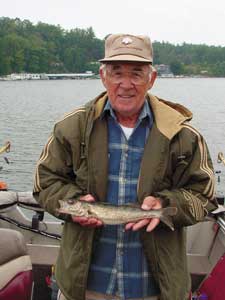
Walleyes and smallmouth bass are the staples of winter fishing in the mountains. Cold weather agrees with them, and when nothing else is biting, you can always count on catching a few smallmouth bass or walleye.
Even in February, the mountains get small windows of spring-like weather. These weather breaks may be short lived, lasting only a day or two, but when water temperatures rise, shad and other forage fish begin schooling, and bass and walleye begin feeding.
A big advantage of winter fishing is that cover is easy to find. Most lakes have been drawn down to winter levels, which makes it easier to locate and catch fish because fish are more concentrated. Another big advantage is the lack of competition. Only the most dedicated anglers get out in the winter. Many times you’ll have the best fishing places to yourself.
Anglers who fish year-round say the secret to winter fishing is to use a slow hand. When the water is cold, fish hunker in and don’t move around much. To catch these fish, you have to ease into them, work your lures and bait slowly, and get them down to where the fish are hanging. You may have to put your lure or bait right in the fish’s face to entice a strike. If the fish doesn’t have to expend too much of its precious energy reserves, it’ll suck it in.
Small crankbaits jigs, and spoons are the preferred lures for wintertime fishing, with the emphasis on “small.”
With other food sources limited, smallmouth and walleye depend primarily on threadfin shad or gizzard shad minnows to survive. For best results, lures should simulate the colors of these forage fish.
David Yow, district fishery biologist for the N.C. Wildlife Resources Commission, said smallmouths and walleyes usually can be found at about the same places during January and February as during July and August — deeper areas of a lake where temperatures are fairly consistent year-round and the water is well oxygenated.
Biologists and avid anglers agree the best smallmouth and walleye lakes are Fontana Reservoir in Macon and Graham counties, Santeetlah Lake in Graham County, Glenville (also called Thorpe) Lake in Jackson County, Lake James in Burke and McDowell counties, and Hiwassee Lake in Cherokee.
Jim Mathis, owner of Almond Boat and RV Park at Fontana Reservoir, said the most effective method of fishing for walleye in the winter is vertical jigging with a 3/8-ounce Hopkins 75 Shorty Spoon, a 1-ounce ManOLure or a Rapala Ice Jig.
“How deep they are depends on the water temperature,” he said. “Finding fish at depths of 125 feet is not uncommon. Some winters they may be deep, and in other winters they may stay in the 70-foot range. There’s no guarantee where they’ll be.”
The key to finding walleyes is finding baitfish.
“You have to watch your fish finder and locate bait fish,” Mathis said. “Shad minnows will go down as deep as 75 to 80 feet trying to find a comfortable temperature range.”
Prime places to look for baitfish and walleyes in the winter are off big points around river channels.
For smallmouth fishing, Mathis said crankbaits are popular, particularly a 1/4-ounce Pop-R in black-and-silver or blue-and-bone.
“The crankbaits work well when smallmouth are breaking and feeding on shad minnows,” he said.
Shiner minnows also are effective baitfish for winter smallmouth fishing. If the fish are in shallow water, some local anglers use a slip bobber when fishing with live minnows. The slip bobber is attached to the line so that the minnow dangles about a foot above the bottom.
Randall Veal, owner of Santeetlah Marina at Santeetlah Lake said anglers often overlook Santeetlah because of its remoteness.
“We have some excellent winter walleye and smallmouth fishing,” he said.
Crankbaits are good throughout the winter, along with live minnows, Veal said. Most popular lures are Yo-Zuri and Shad Rap.
“Perch and shad colors are best because they resemble shad minnows,” he said.
Lake Glenville in western Jackson County also offers some excellent winter walleye and smallmouth bass fishing.
Marty Jones of Glenville said walleyes in the 6- to 7-pound range are fairly common, plus anglers occasionally pull in a few that reach 9 pounds. The biggest walleye to come from Glenville weighed 12 pounds. Smallmouth bass up to 8 pounds also have been caught.
“It’s not the kind of lake to limit out on every day,” Jones said, “but you can catch some good quality fish.”
Jones’ preferred method of fishing for walleyes and smallmouths is trolling with his own Marty Jones Special spoon or a No. 7 or No. 5 Rapala. For breaking smallmouth, he uses a Pop-R.
Fishing may be a bit slower in the winter, but with a little patience and planning, anglers can fish year-round.
Watch for a warm spell, get your tackle out of storage, hitch up the boat, and head for some good fishing.
The fish will be waiting for you, and, best of all, you’ll likely have the prime spots all to yourself.




Be the first to comment